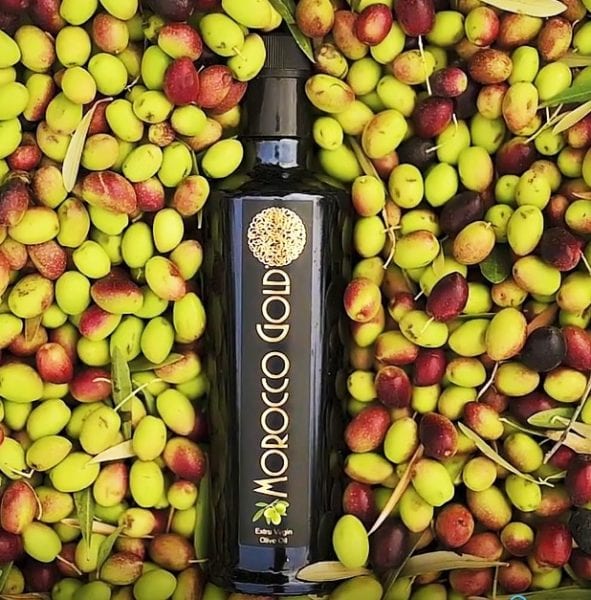Why you should include polyphenols in your healthy diet and where to find them – including extra virgin olive oil.

Phenolic compounds, ubiquitous in plants, are of considerable interest and have received more and more attention in recent years due to their bioactive functions. Polyphenols are amongst the most desirable phytochemicals due to their antioxidant activity. These components are known as secondary plant metabolites and possess also antimicrobial, antiviral and anti-inflammatory properties along with their high antioxidant capacity.
Contents:
- Why Are Polyphenols Good For You?
- High-polyphenol Foods
- Benefits Of High Polyphenol Foods
- Polyphenols In Morocco Gold Extra Virgin Olive Oil
- Types Of Polyphenols In Morocco Gold Extra Virgin Olive Oil
- Polyphenols Shown to Have Distinct Anti-Bacterial Properties
- Healthy Compounds In Extra Virgin Olive Oil Still Present After Exposure To Heat
Why are polyphenols good for you?
Polyphenols are a category of chemicals that naturally occur in plants. There are more than 500 unique polyphenols. Collectively, these chemicals are known as phytochemicals.
Polyphenols can be further categorized into the following groups:
- flavonoids
- phenolic acids
- stilbenes
- lignans
High-polyphenol foods
Various herbs and spices contain polyphenols, including star anise, peppermint, and cinnamon.Plant-based foods such as vegetables and fruits tend to be high in polyphenols.
The number of polyphenols in a food can vary depending on where the food is grown, how it is farmed and transported, how ripe it is, and how it is cooked or prepared.
Here are some of the most common sources of dietary polyphenols:
| Food Group | Some major sources of polyphenols |
|---|---|
| Fruits | oranges, apples, grapes, peaches, grapefruit juice, cherries, blueberries, pomegranate juice, raspberries, cranberries, black elderberries, blackcurrants, plums, blackberries, strawberries, apricots |
| Vegetables | spinach, onions, shallots, potatoes, black and green olives, globe artichoke heads, broccoli, asparagus, carrots |
| Whole grains | whole grain wheat, rye, and oat flours |
| Nuts, seeds, and legumes | roasted soybeans, black beans, white beans, chestnuts, hazelnuts, pecans, almonds, walnuts, flaxseed |
| Beverages | coffee, tea, red wine |
| Fats | dark chocolate, virgin olive oil, sesame seed oil |
| Spices and seasonings | cocoa powder, capers, saffron, dried oregano, dried rosemary, soy sauce, cloves, dried peppermint, star anise, celery seed, dried sage, dried spearmint, dried thyme, dried basil, curry powder, dried ginger, cumin, cinnamon |
Benefits Of High Polyphenol Foods
Polyphenols may help to reduce the risk of developing type 2 diabetes. Many of the health benefits associated with polyphenols may be related to their role as antioxidants. Antioxidants are known for their ability to combat cell damage.
Polyphenols may also impact genes and gene expression. A person’s specific genes can also affect how their body responds to certain types of polyphenols. Polyphenols may even influence gut bacteria.
Type 2 diabetes
Some researchers have reported that polyphenols may lower the risk for type 2 diabetes. Polyphenols may boost insulin sensitivity, as well as slow down the rate the body digests and absorbs sugar.
According to one review, a type of flavonoid called flavan-3-ols may be especially beneficial for lowering insulin resistance. The same review also found that flavonoids seem to be the type of polyphenol most often associated with a lower risk for type 2 diabetes.
An analysis of studies on flavonoid intake and type 2 diabetes concluded that people who consumed the most flavonoids had a lower risk of developing type 2 diabetes than those who took in the least. Increasing flavonoid intake also appeared to be a way to reduce the risk of disease significantly.
Unprocessed cocoa is a rich source of flavonoids. One review found that cocoa consumption significantly decreased a marker of insulin resistance. It is worth noting that unprocessed cocoa is very different from the chocolate in candy bars or traditional desserts. Unprocessed cocoa comes straight from the cacao plant with no sugar added.
Inflammation
A study in animals looked at the effect of green tea polyphenols on measures of inflammation after exercise. Rats that received the tea polyphenols were able to keep up their activity for longer than the rats that did not receive the polyphenols. They also had significantly lower levels of chemicals that signaled inflammation and muscle damage in their blood.
Lignans are a class of polyphenols that occur at their highest levels in extra virgin olive oil, flaxseed, and whole grain rye flour. One way to study lignan intake is to look at levels of lignans in urine.
In a study of adults in the United States, researchers found that higher levels of lignans in the urine were associated with lower levels of measures of inflammation. This could be important since long-term inflammation has been associated with certain diseases, such as heart disease and cancer.
Heart disease
A review of studies looked at the impact of cocoa polyphenols on risk factors for heart disease. Scientists found that consuming cocoa for at least 2 weeks led to a significant decrease in blood pressure. They also found that cocoa significantly decreased LDL or “bad” cholesterol, and raised HDL or “good” cholesterol.
Obesity
Polyphenol intake may also play a role in body weight regulation.
One study compared the intake of flavonoids, a class of polyphenols, with body mass index (BMI) and waist circumference. Researchers found that a higher flavonoid intake was associated with lower BMI and waist circumference.
These results are significant because obesity is associated with a higher risk for many chronic diseases
Polyphenols In Morocco Gold Extra Virgin Olive Oil
Extra Virgin Olive Oil is probably the most extensively researched foodstuff on the planet and the health benefits are evidence based. Thanks to the recent spotlight on the Mediterranean Diet, extensive research has been done on the phytonutrient composition of extra virgin olive oil. What has been discovered is an extensive list of phytonutrients; one of the most praised is its polyphenols. The amount of polyphenols found in extra virgin olive oil is truly amazing!
The high polyphenol content of Morocco Gold extra virgin olive oil is dependent on three factors. First is the variety of the olive, secondly the climate and terroire of the growing region and thirdly the actual time in the growing season that the crop is harvested.
Morocco Gold is pressed from the Picholine Marocaine, the only type of olive to go into Morocco Gold. Oil from this variety is renowned for it’s high polyphenol count, oxidative stability and longevity.
Our olives are grown in a valley that is about 2,000 feet above sea level. This helps to create the additional climatic challenges that encourage polyphenol uptake within the olive tree. It is also an area with naturally occurring high phenols in the soil itself.
In soils, phenols are released over extended period of time from decomposing plant materials. This causes complex organic compounds to be slowly oxidized or to break down into simpler forms of sugars, amino sugars, aliphatic and phenolic organic acids. These are further transformed into microbial biomass or are reorganized, and further oxidized, into humic assemblages (fulvic and humic acids), which bind to clay minerals.
Olive trees grown in ‘challenging’ conditions encourage the uptake of naturally occurring phenols in the soil. This in turn aids the circulatory system within the olive tree, with the phenols eventually finding their way to the olive fruit itself.
Thirdly, our olives are picked when the fruit is young and green. As the olives age on the tree, the colour of the olive changes to red and then black, the size of the olive increases thus producing more oil, but the polyphenol level decreases. There is a great deal of expertise within the farming community where we source our oil to ensure that the harvest is collected at the optimum time to maximise the polyphenol level.
Types Of Polyphenols In Morocco Gold Extra Virgin Olive Oil
There are a number of different types of polyphenols in Morocco Gold Extra Virgin olive oil, including oleuropein, tyrosol, hydroxytyrosol, oleocanthal and oleacein. Each are considered extremely strong antioxidants, and are linked to a number of different benefits, including:
- Maintenance of normal blood pressure
- Keeping the upper respiratory tract healthy
- Protecting proteins in the brain that are involved in memory, learning and thinking
- Helping to keep blood sugar under control
- Treating the symptoms of and/or preventing type 2 diabetes
- Protecting blood lipids from oxidative damage
- Acting as an anti-inflamatory
Polyphenols Shown to Have Distinct Anti-Bacterial Properties
Research on the antibacterial activity of olive varieties grown in southern Italy have also now shown promise for natural treatments against E. coli and Pseudomonas aeruginosa.
Healthy Compounds In Extra Virgin Olive Oil Still Present After Exposure To Heat
New research confirms the key components in extra virgin olive oil survive temperature. The most healthy compounds found in extra virgin olive oil do not disappear when the oil is used for cooking, according to new research published in the scientific journal, Antioxidants. The implication may have an impact on future nutritional guidelines.
Researchers from the University of Barcelona focused on evaluating how the attributes of olive oil change when it is used for sautéing in a household kitchen. After cooking at a moderate temperature, (polyphenols and antioxidants) were still in the oil and in concentrations high enough to meet the E.U. parameters, meaning this oil should be used for cooking.– Julián Lozano Castellón, project coordinator
Summary
Overall, polyphenols appear to offer many promising health benefits. More research is needed before polyphenols can be recommended in supplemental doses, however.
For now, it is best to consume polyphenols in their natural form of plant foods. The Mediterranean diet is one eating pattern that includes many foods that are rich in polyphenols.
